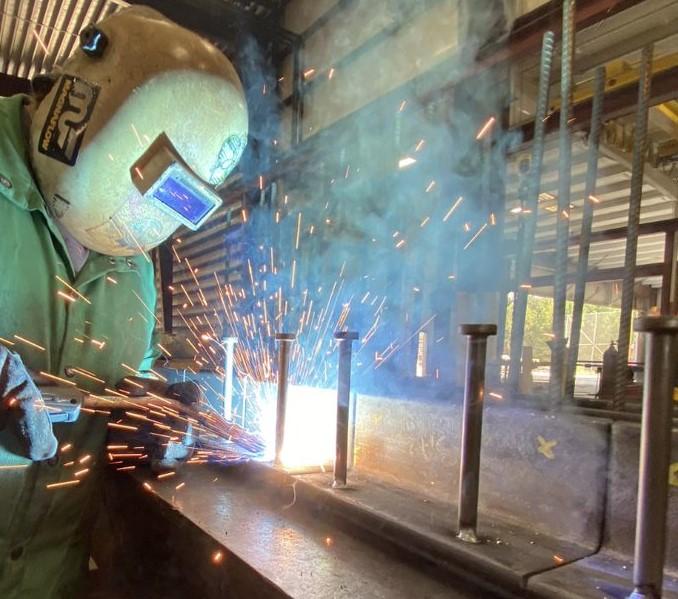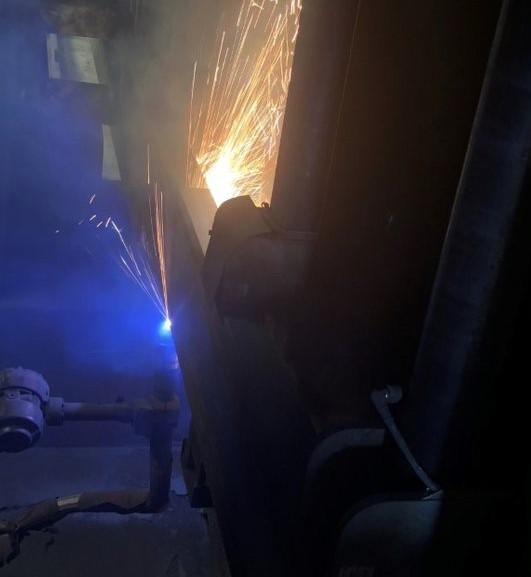Senior Editor
- FMA
- The Fabricator
- FABTECH
- Canadian Metalworking
Categories
- Additive Manufacturing
- Aluminum Welding
- Arc Welding
- Assembly and Joining
- Automation and Robotics
- Bending and Forming
- Consumables
- Cutting and Weld Prep
- Electric Vehicles
- En Español
- Finishing
- Hydroforming
- Laser Cutting
- Laser Welding
- Machining
- Manufacturing Software
- Materials Handling
- Metals/Materials
- Oxyfuel Cutting
- Plasma Cutting
- Power Tools
- Punching and Other Holemaking
- Roll Forming
- Safety
- Sawing
- Shearing
- Shop Management
- Testing and Measuring
- Tube and Pipe Fabrication
- Tube and Pipe Production
- Waterjet Cutting
Industry Directory
Webcasts
Podcasts
FAB 40
Advertise
Subscribe
Account Login
Search
How one structural fabricator boosts throughput
Speed is everything at Georgia-based warehouse construction fab shop Division 5
- By Tim Heston
- December 28, 2020
- Article
- Shop Management
Bryan Hill and Rhonda Wylie, brother and sister, grew up in the Atlanta region’s structural steel business, not in fabrication but in erection. Their father owned a local steel erector, and from the early 1980s the two witnessed the erection business in action. They knew all about erection aids, how expensive field fabricating and welding was, and that some of it would have probably been far less expensive if done at the structural fabricator.
So when a local fab shop closed its doors in 2000 and two managers from that company approached the siblings about launching a structural fabricator, they jumped at the chance. They called their new business Division 5, after the “Division 05 - Metals” section of the Construction Specifications Institute’s building construction standards manual that accompanies commercial construction projects.
“We were surprised the name wasn’t already taken,” Hill said.
CSI’s 50 Divisions spec standard, in which metals is the fifth, is often referred to as the Dewey Decimal System of construction, giving the industry a standard format to clarify and streamline communications. Growing up in steel erection, the Hills saw firsthand how expensive miscommunication could be. More than that, a lack of communication can keep unrealized savings forever hidden, not just for the structural fabricator, but for the entire construction supply chain.
“In this business, speed is everything,” Hill said—and not just speed through the fab shop, but throughout the entire value chain, from engineering and detailing to fabrication to steel erection.
From Brick-and-Mortar Retail to E-Commerce
When Division 5 launched in 2001, starting with a small loan from their father, the siblings—Hill as CEO and Wylie as CFO—won work by building on prior relationships with general contractors and detailers in the Southeast. They started out of a 12,000-sq.-ft. facility in Winston, Ga., west of the city, and in 2004 moved into a 30,000-sq.-ft. plant 2 miles away.
Brick-and-mortar retail comprised a large portion of the fabricator’s work, but then came the economic downturn, which hit Division 5 hardest in 2010. Retail work declined and the company needed to shift gears. Atlanta wouldn’t exist without the railroad, which in turn gave birth to the city’s logistics industry. And without warehouses, the logistics business couldn’t exist either. Neither could e-commerce, a sector that has played a central role in Division 5’s growth over the past 10 years.
Serving the warehouse market is unique in structural fabrication, mainly because of the sheer tonnage of material that must depart Division 5’s shipping dock in a short period. “A typical million-square-foot facility might take six months [to be constructed],” Hill said. “For a million-square-foot warehouse, you need to deliver the steel in three weeks.”
Again, speed is the name of the game, and over the years Division 5 has boosted its throughput in several ways. It has of course boosted its technology investment, most recently purchasing a plasma cutting, drilling, and coping center. It also brought detailing in-house, a change that in retrospect has had the greatest impact on the shop’s throughput. A new machine can shave hours off a cycle time, but a fine-tuned in-house detailing operation can shave days or even weeks off overall delivery time.
“In 2010 we found that we were spending a few million dollars a year in outsourced detailing,” said Wylie. “Today we have a team of 12 detailers. We tell them exactly what we want for fabrication and erection.”

Riding the e-commerce wave, Georgia-based Division 5 has become a go-to fabricator for warehouse construction. But the boom won’t last forever.
She added that this complements the company’s close relationship with project engineers and general contractors. “We’ve built relationships with engineers since 2001. We generally don’t have delays because of RFIs [request for information], but if we do have a question about something, we pick up the phone to get an answer. We may sell a job today and deliver it in five weeks. A lot of time we get work that way, simply because others say they can’t do it.”
According to Hill, Division 5 makes quick delivery happen with several strategies. First is reduced material handling. Automation plays a role, but so does the company’s approach to cross-training and the placement of welding stations. When a beam that requires welding emerges from the line, it doesn’t need to be carried to a separate welding station but instead is welded on the same line. Also, many who weld also fit, and vice versa, depending on the station in the shop.
“And yes, we spend a few more dollars an hour in fitting and welding,” Hill said. “But the cost savings achieved through reduced handling blows the additional labor costs out of the water.”
The company also has a proprietary line dedicated to hollow structural sections, designed in-house by Mark Buchanan, the GM of the company’s plant in Tallapoosa, Ga., and Chris Gravett, Division 5’s operations manager. “There’s no off-the-shelf equipment either,” Hill said. “They designed it from the ground up.”
The resulting increased throughput reduced the company’s costs to the point where it can look at the big picture and do what’s best for the overall project, not just the fab shop. One prime example comes from Division 5’s work with Walgreens. Next time you visit the pharmacy, look up, and you might see a steel canopy 12 or 14 ft. wide spanning over the front door.
“When I started in this business, we did a lot of Walgreens work in which we sent the canopy out in pieces,” Hill recalled. “We now build it all in the shop. It used to take erectors two or three days. Now it takes them three hours.”
Sure, proposing in-shop fabrication might require approval, and Division 5 might even have to subcontract with a connection engineer to design the best connections and get approval from the engineer of record. And transporting the canopy fabrication in one piece might require extra permitting, which of course isn’t free. But compare those costs to that of on-site field work over several days, and the decision becomes a no-brainer.
Weld splices are another example of how Division 5 maintains constant communication with the erector. “I remember when I was an erector, before I was a fabricator, the drawings called for field welds, field welds, and more field welds,” Hill said. “We have a different mindset here. No matter who’s the erector, as a fabricator I know for a fact that welding in the shop is less expensive than welding on-site.”
Scaling Up
In 2018 representatives from New York-based investment and consulting firm Applied Value Group traveled to Atlanta to perform some due diligence—and were impressed. “They saw how we’ve been putting money back into the business for years,” Wylie said.
At that time Division 5 had two plants in Georgia, one in Winston and another in Tallapoosa. It had gained a strong presence in the warehousing sector, and for years it had worked to shorten lead times and increase throughput.

Last year Division 5 invested in a plasma center for automated cutting, drilling, and coping of structural beams.
Earlier that year one of the siblings’ original business partners had died, so the siblings dipped their toes into the M&A market to see who the potential buyers were. “Bryan and I had numerous offers on the business that we turned down,” Wylie said, adding that they could see a lot of investment firms were interested in “flipping the business quickly.
“We had no intention of selling the business and walking away,” Wylie continued. “We wanted to have someone onboard who could give us the strong financial backing, to help us grow to be one of the larger structural fabricators in the U.S.”
They found that in Applied Value, an investment firm that also does a significant amount of consulting work on the buy side (such as OEMs) of the metals business. “We as a firm have a lot of experience in the metals industry,” said Max Sultan, Applied Value’s lead director for Division 5. “We were interested in Division 5 because of its market focus … With the boom of e-commerce, distribution and warehousing are growing incredibly fast. That’s where the initial interest came from. When Applied Value purchased Division 5, e-commerce represented about 15% of all retail. Now that number is closer to 20%, depending on the source you read. Regardless, the projection is that by 2030 e-commerce will be closer to 40% of all retail.”
Since Applied Value’s purchase in November 2018, the fabricator has ramped up its capital equipment investment. It’s also tapped into Applied Value’s purchasing expertise. Most significant, Applied Value has given the organization the capital it needs to expand its footprint in the Southeast. In July 2020 it purchased Structural Steel of Carolina (SSC) based in Winston-Salem, N.C.
Today the combined organization has more than 350 employees and 350,000 sq. ft. under roof with the capacity to process more than 75,000 tons of steel a year. The acquisition also broadened its end market—a sign that the siblings aren’t just riding high on the warehouse boom driven by e-commerce.
And a boom it has been. One of Division 5’s most recent projects is the almost 700,000-sq.-ft. Amazon fulfillment center in Stone Mountain, Ga., east of Atlanta.
The company provided only the miscellaneous steel for the project, but regardless, the size of the facility puts things in perspective. Two decades ago, 700,000 sq. ft. would have been considered a massive warehouse. Now it’s midsized.
“Back in the 1990s, a 300,00-sq.-ft. warehouse seemed huge,” Hill said. “Now, that’s what we consider a small building. We’re fabricating steel for facilities that are 1, 2, even 3 million sq. ft.”
The boom has boosted growth even through the pandemic. “We really have not missed a beat in 2020,” Wylie said. “We of course put safety and cleaning protocols in place early. Sales-wise, we’ve met or beaten our goal every quarter.”
“We don’t publicize our growth numbers,” Sultan said, “but we’ve continued to see growth and increased volumes of bids in the market, and we continue to see bigger and bigger projects coming to market. There was initial uncertainty [with the lockdown] earlier this year, but we couldn’t see any underlying damage to the underlying market.”
Still, all booms must end, a fact that was top of mind when bringing SSC into the fold. “We didn’t want another fabricator that did what we do,” Hill said. “We have the warehouse market. E-commerce is exploding and the expansion will be there for several more years, but it’s not going to last forever. We needed to diversify.”
Unlike Division 5, SSC focuses on government work, including schools and police stations, as well as health care facilities. “It’s diversifying our overall portfolio of work,” Wylie said.
Considering Hill and Wylie’s history in the erection business, would Applied Value and Division 5 consider purchasing a steel erector? “No, we’ll keep the fabrication and erection separate,” Hill said, who added that although he knows a few large fabricators with successful erection divisions, “I’ve also seen putting fabrication and erection under one umbrella fail. Those who work in the field are just entirely different kind of people.”
Besides the cultural differences between the two types of companies, Hill said that the demand for speed has pushed the industry toward more specialization. “There are many erectors that can put steel up, but there are not a lot of erectors that can put steel up as fast as it needs to be done now.”
So for the foreseeable future, Division 5’s strategy remains unchanged: Consider overall costs throughout the construction value chain, maintain a cross-trained workforce, and, not least, keep an unrelenting focus on throughput.
About the Author

Tim Heston
2135 Point Blvd
Elgin, IL 60123
815-381-1314
Tim Heston, The Fabricator's senior editor, has covered the metal fabrication industry since 1998, starting his career at the American Welding Society's Welding Journal. Since then he has covered the full range of metal fabrication processes, from stamping, bending, and cutting to grinding and polishing. He joined The Fabricator's staff in October 2007.
subscribe now

The Fabricator is North America's leading magazine for the metal forming and fabricating industry. The magazine delivers the news, technical articles, and case histories that enable fabricators to do their jobs more efficiently. The Fabricator has served the industry since 1970.
start your free subscription- Stay connected from anywhere

Easily access valuable industry resources now with full access to the digital edition of The Fabricator.

Easily access valuable industry resources now with full access to the digital edition of The Welder.

Easily access valuable industry resources now with full access to the digital edition of The Tube and Pipe Journal.
- Podcasting
- Podcast:
- The Fabricator Podcast
- Published:
- 04/30/2024
- Running Time:
- 53:00
Seth Feldman of Iowa-based Wertzbaugher Services joins The Fabricator Podcast to offer his take as a Gen Zer...
- Industry Events
Pipe and Tube Conference
- May 21 - 22, 2024
- Omaha, NE
World-Class Roll Forming Workshop
- June 5 - 6, 2024
- Louisville, KY
Advanced Laser Application Workshop
- June 25 - 27, 2024
- Novi, MI
Precision Press Brake Certificate Course
- July 31 - August 1, 2024
- Elgin,
































